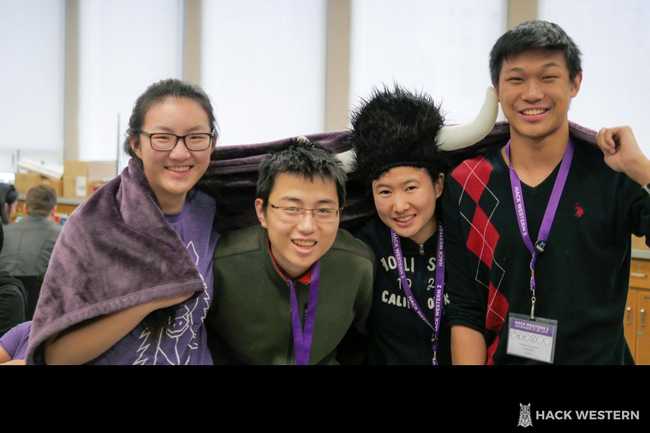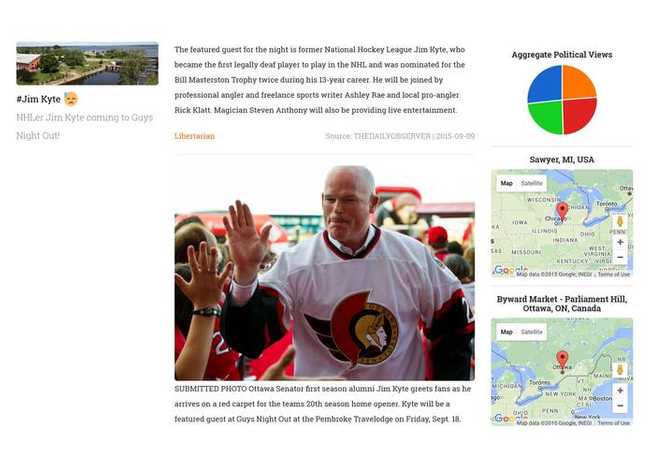Hack Western
Sunday, November 29, 2015
CompetitionHackathonProgrammingMachine learning

Introduction
This weekend, I attended Hack Western with a few of my SHAD friends (Kevin, Lilian, and Katherine). It was a really great experience and we even came home with a sponsor prize! Going into Hack Western, I am pretty sure that my team had zero idea of how to proceed from our initial idea. A week before Hack Western, Kevin had a really great idea of a live-updated trend-based news-aggregator web application. Essentially what it did was scrape a bunch of articles related to a specific trend and find the top keywords from all the articles. Then it would determine the best paragraphs from the best sources based on length, conciseness, views, and factual information. The paragraphs would be pushed to Firebase which was finally pulled and displayed on the website.
APIs
So you are probably thinking the same thing as we did when we started the hackathon: how the hell are we supposed to do that? Well it turns out that the process was relatively simple once we got the ball rolling. The first we did was split up into groups; Kevin started designing and working on the frontend while Lilian, Katherine, and I sorted everything out on the backend. We decided to use Python because it was one of the most intuitive languages to use.
Our first big issue was how we were going to get the trends. In the end, we decided to pull them from Twitter's trending hashtags using its API. The only problem was that hashtags were one word and we were afraid that we wouldn't be able to pick up any relevant articles. I attempted to use a greedy substring matching algorithm and Aho-Corasick to try to split the hashtags into phrases. However, there were too many "valid" phrases and exhaustively searching news articles for each phrase would be computationally heavy and yield too many of the same results. After brooding long and hard over the issue, we decided to screw it and directly search for the hashtag.
Next up, we used Bing's Search API to find the top thirty news articles. That step was pretty simple -- we used some code we found on StackOverflow for the API to work with Python. After that, we found a nice web scraper tool in Python called Newspaper. Now we were getting down to the nitty-gritty of actually processing the articles. We used Indico to determine the keywords for each paragraph.
Algorithmic Magic
Then we encountered our second big issue: how are we supposed to determine the best articles without repeating facts and getting the entire picture?
I came up with a great idea of creating a bipartite graph using the paragraphs and keywords as nodes. Maximal matching will then determine the minimum number of paragraphs that could cover all the content. Of course, this process might yield irrelevant results so we only used the most frequent keywords. After implementing Kuhn's algorithm (it was a surprise that I still knew how it worked!), we tested our program and it yielded pretty nice results.

Whew! A big portion of our backend was completed at this point. We checked the time and to our surprise, only 11 hours had passed -- we still had over two-thirds of the hackathon left. The simplicity of Python (especially its imports) really helped especially since we were using so many APIs.
import urllib2
import json
import Queue
import indicoio
from firebase import firebase
from random import shuffle
from twitter import *
from newspaper import Article
import wolframalpha
import simplejson
import os
import sys
import struct
import imghdr
import time
from BeautifulSoup import BeautifulSoup
from googleplaces import GooglePlaces, types, langData Visualization and Images
The great thing about Indico is that it also gave us entities, political sentiment, and positivity. We used the entities, Wolfram Alpha API, and Google Places API to obtain some location information about the paragraphs. We used the next few hours to create pretty data visualizations with the political sentiments, and positivity measure. We spent the next eight hours in the hackathon working on the user interface, incorporating all the information, and finalizing our algorithm to select the best paragraphs.
Staying up for nearly 24 hours, I fell asleep soon after. To my surprise when I woke up, my team had
gotten image extraction working. Using
BeautifulSoup, they were able to find images by
locating the <img> tag. However, that extracted all the images from a webpage (even the ones on
the side and navigation bars), so they used the alt attribute to determine if an image was
relevant.
Conclusion
The rest of the hackathon was rather unproductive since we had pretty much finished. Kevin used Ionic to port In the Loop to Android and iOS. I thought that we had a pretty good shot at a couple of the prizes (Best Data Visualization, Best Life Hack, Best Open Source, and Best Social Impact), but after seeing the other projects I was unsure. I really wanted the Best Social Impact prize since they were giving out Bluetooth headphones. In the end, we got the Best Life Hack prize which was a pleasant surprise. Overall, Hack Western was a great experience and I was really happy that we built such a functional and well-designed web application in just 36 hours! I learned a lot about the different APIs out there, and especially how powerful Indico is!
Check out In the Loop in action!